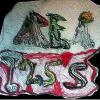Just threw this together, I think this will shed more light on the receptor, as it stands, only two available ligands for this sketchy receptor.
ALL ABOUT THE 5-HT5A RECEPTOR AND IT'S LIGANDS / CHEMICALS
Valerian extract and valerinic acid are partial agonists; increasing serotonin by selective modulation of the autoreceptor, and decreasing cyclic AMP on some of the other terminals.
Brain Res Mol Brain Res. 2005 Aug 18;138(2):191-7.
Valerian extract and valerenic acid are partial agonists of the 5-HT5A receptor in vitro.AbstractInsomnia is the most frequently encountered sleep complaint worldwide. While many prescription drugs are used to treat insomnia, extracts of valerian (Valeriana officinalis L., Valerianaceae) are also used for the treatment of insomnia and restlessness. To determine novel mechanisms of action, radioligand binding studies were performed with valerian extracts (100% methanol, 50% methanol, dichloromethane [DCM], and petroleum ether [PE]) at the melatonin, glutamate, and GABA(A) receptors, and 8 serotonin receptor subtypes. Both DCM and PE extracts had strong binding affinity to the 5-HT(5a) receptor, but only weak binding affinity to the 5-HT(2b) and the serotonin transporter. Subsequent binding studies focused on the 5-HT(5a) receptor due to the distribution of this receptor in the suprachiasmatic nucleus of the brain, which is implicated in the sleep-wake cycle. The PE extract inhibited [(3)H]lysergic acid diethylamide (LSD) binding to the human 5-HT(5a) receptor (86% at 50 microg/ml) and the DCM extract inhibited LSD binding by 51%. Generation of an IC(50) curve for the PE extract produced a biphasic curve, thus GTP shift experiments were also performed. In the absence of GTP, the competition curve was biphasic (two affinity sites) with an IC(50) of 15.7 ng/ml for the high-affinity state and 27.7 microg/ml for the low-affinity state. The addition of GTP (100 microM) resulted in a right-hand shift of the binding curve with an IC(50) of 11.4 microg/ml. Valerenic acid, the active constituent of both extracts, had an IC(50) of 17.2 microM. These results indicate that valerian and valerenic acid are new partial agonists of the 5-HT(5a) receptor.
PMID: 15921820 [PubMed - indexed for MEDLINE]
AND DIMEBON/DIMEBOLIN/LATREPIRDINE IS AN ANTAGONIST at 5-HT5A, THUS ENHANCING CYCLIC AMP AND SEROTONIN BOTH!
Moreover, dimebon also binds with high affinity to several serotoninergic receptors [28,37], in particular 5-HT5A receptors, which are expressed in astrocytes [38]. It is well known that astrocytes play a pivotal role in brain homeostasis, and together with microglia are the cellular elements involved in neuroinflammation, a defense mechanism, which protect neurons against brain insult [39]. Enlargement of astrocytes and increased expression of GFAP is an indication of reactive astrocytes (gliosis) in response to brain damage. In addition, astrocytes display large amounts of Aβ, suggesting that they play a role in Aβ clearance [40]. We suggest that dimebon promotes a mechanism of neuroprotection against Aβ and other insults via astrocytic stimulation. On the other hand, chronic activation of astrocytes could have a detrimental role in the development of AD via the overexpression of the proinflammatory cytokine interleukin 1 (IL-1), which can induce plaque formation [41-43] and lead to neuronal death rather than protection [44]. Future studies are needed to explore the potential effects of dimebon upon neuroinflammation in AD.
http://en.wikipedia....ki/Latrepirdine
http://www.ncbi.nlm....les/PMC3466490/













































